MAP 3rd Grade Practice Test & Expert Prep - Boost Your Scores in Math, Reading & Language
Every hour of practice brings your child closer to success.

Hey there! Do you have a question about the test or our practice package? Email me at roman@staggingapps.website. I'm here to help your child succeed!
Free MAP 3rd Grade Practice Test (Math, Reading, Language Usage, and Science)
Explore these sample questions (drawn from our comprehensive practice pack) with your child to help them become familiar with the types of questions they might encounter on the test.
The MAP 3rd Grade assessment typically includes three to four sections, each containing 40 to 53 questions.
These sections cover Math, Reading, Language Usage (also referred to as Language Arts or ELA), and, in some cases, Science, depending on the school.
(We’ll break down each section in greater detail later on this page.)
The MAP Test is untimed and adaptive, adjusting its difficulty level based on how your child answers each question.
- Correct answers lead to more challenging questions.
- Incorrect answers result in easier questions.
This adaptive structure categorizes difficulty levels into below grade level, at grade level, and above grade level.
To give you a sense of these levels, the sample questions below are grouped accordingly.
NWEA MAP 3rd Grade Math Practice Questions
Below-Grade-Level Sample Question
If your child answers a few questions incorrectly, the next question they will receive will be below grade level. Here’s an example of such a question:
Which figure illustrates 4/5?

Show Answer
Answer: B
4/5 means there are four shaded parts out of 5 equal parts.
The numerator (number on top) represents the number of shaded parts while the denominator (number at the bottom) represents the total parts the figure was equally divided.
Option A has two shaded parts out of five equal parts. So, it represents 2/5.
Option B has four shaded parts out of five equal parts. So, it represents 4/5.
Option C has four shaded parts out of seven equal parts. So, it represents 4/7.
Option D has three shaded parts out of ten equal parts. So, it represents 3/10.
Therefore, option B correctly represents 4/5.
At-Grade-Level Sample Question
If your child answers a below-grade-level question correctly, the next question will be slightly harder – at grade level. Here’s an example:
Based on the data presented on the bar graph, what month did the Smith family have the highest expenses?
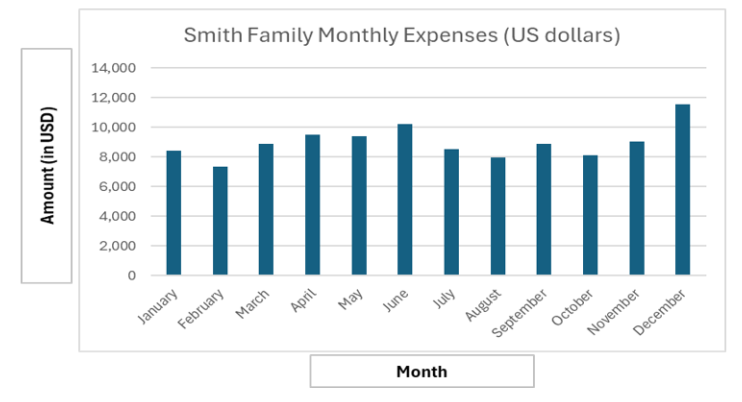
A) January
B) March
C) June
D) September
E) December
Welcome to the ultimate preparation guide for the NWEA MAP Test for 3rd Grade!
To help your child achieve top scores, excel in academics, and gain admission to advanced programs, we’ve crafted a proven preparation method that has supported many students in reaching their goals:
- Start with a Free Practice Test: Use our free MAP 3rd Grade practice test below to experience the test format and pinpoint areas needing improvement.
- Ready for More? Access the full preparation package, including 21 practice tests and 420 questions, tailored to boost your child’s confidence and performance.
Let’s prepare your child for success on the test!
Show Answer
Answer: E
To determine which month had the highest expenses:
First, look at the bars representing each month on the graph. Next, compare the heights of the bars. The taller the bar, the higher the expenses for that month. Identify which bar is the tallest. This will correspond to the month with the highest expenses. Lastly, check the label under the tallest bar to see which month it represents.
Thus, the Smith family had the highest expenses in December.
Above-Grade-Level Sample Question
These questions are more challenging for children in Grade 3 and are taken from the pool of questions for 4th grade and above.
Here’s an example:
Which linear equation represents the triangle when the perimeter is 22 units?
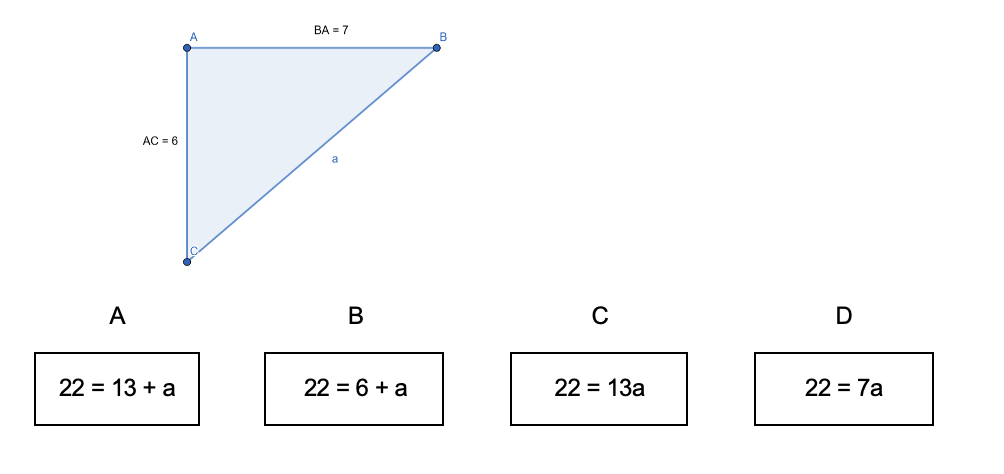
Show Answer
Answer: A
To find the linear equation representing the triangle’s perimeter, we can use the formula for the perimeter of a triangle, which is the sum of the lengths of all its sides.
Given:
Side BA = 7 units
Side AC = 6 units
Side a = the unknown side
The perimeter is given as 22 units.
Perimeter = BA + AC + a
Substituting the values we have: 22 = 7 + 6 + a
Now, simplify the equation:
22 = 7 + 6 + a
22 = 13 + a
So, the linear equation representing the perimeter of the triangle is:
22 = 13 + a
This shows that the unknown side (a) plus the sum of the other two sides equals the perimeter of 22 units.
Does your child find math challenging? Don’t worry—many kids experience the same at this stage.
Encourage your child with small daily practices—they’ll build confidence as they improve.
Every bit of practice counts, and with time, your child will build strong math skills.
Looking for ways to support your child’s math skills? Get our practice package with over 140 Math practice questions designed just for them.
Boost Your Child's MAP Test Scores
Help your child prepare with a complete practice package designed to maximize their performance on the MAP 3rd Grade test.
Build Confidence with Realistic Practice Tests
Master All Test Areas with 18 Quizzes in Varying Levels
Gain an Edge with Expert-Created Resources
NWEA MAP 3rd Grade Reading Practice Questions
Below-Grade-Level Sample Question
Read the index.
Alcott, Louisa May – pages 45–89
Baum, L. Frank – pages 90–134
Carroll, Lewis – pages 135–165
Montgomery, L. M. – pages 166–210
Twain, Mark – pages 211–250
Based on the index, on which of the following pages would you find a story by Lewis Carroll?
A. page 120
B. page 140
C. page 170
D. page 220
Show Answer
The index indicates that stories by Lewis Carroll can be found on pages 135–165. Page 140 falls within this range, so option B is the correct answer.
At-Grade-Level Sample Question
Read the passage.
Olive oil is made from olives, which are harvested from olive trees when they are fully ripe. Once harvested, the olives are washed to remove dirt and impurities. The cleaned olives are then crushed to create a paste. This paste is pressed to extract the liquid, which contains both water and oil. The mixture is then separated to remove the water, leaving behind pure olive oil. The final product is filtered, bottled, and distributed to stores.
Which of the following order of directions best fits olive oil’s production process?
A. Olives are washed, harvested, and then crushed to create a paste.
B. Olives are crushed, pressed, and separated to remove water before being bottled.
C. Olives are harvested, bottled, and then pressed to extract water and oil.
D. Olives are harvested, washed, crushed into a paste, pressed, and then separated to remove water.
Show Answer
The correct answer is D: Olives are harvested, washed, crushed into a paste, pressed, and then separated to remove water.
The explanation of olive oil production in the passage emphasizes that the process begins with harvesting, followed by washing, crushing, pressing, separating, filtering, and bottling, making option D the most accurate choice.
Above-Grade-Level Sample Question
Read the passage.
Usain Bolt, often referred to as the fastest man alive, is a retired Jamaican sprinter who is an eight-time Olympic gold medalist. Bolt set world records in the 100-meter, 200-meter, and 4100-meter relay, with times that remain unbroken to this day. Born on August 21, 1986, in Trelawny, Jamaica, Bolt began running competitively in his teenage years and quickly gained recognition for his unmatched speed and unique charisma. By the age of 20, he had qualified for his first Olympics, where he demonstrated his potential on the global stage.
In the 2008 Beijing Olympics, Bolt became a household name, winning three gold medals and setting new world records in all his events. His dominance continued in the 2012 and 2016 Olympics, where he repeated his triumphs and earned the title of the greatest sprinter in history. Bolt retired in 2017 but remains an influential figure in the world of sports. Fans and analysts often discuss his remarkable speed and his legacy in athletics.
Which of the following details cannot be found in the passage?
A. The total number of Usain Bolt’s Olympic gold medals
B. The year Usain Bolt retired from competitive running
C. The specific times of Bolt’s world records
D. The age Usain Bolt qualified for his first Olympics
Show Answer
The correct answer is C. The specific times of Bolt’s world records.
The passage provides several specific details about Usain Bolt’s career:
• The total number of Olympic gold medals (eight).
• The year he retired from competitive running (2017).
• The age he qualified for his first Olympics (20).
However, the exact times of his world records are not mentioned, making Option C the correct answer.
NWEA MAP 3rd Grade Language Usage Practice Questions
Below-Grade-Level Sample Question
Read the paragraph.
Dolphins are known for their intelligence and friendly behavior. They can learn complex tricks and often enjoy interacting with people. Dolphins use a system of clicks and whistles to communicate with each other.
Which of the following sentences could be a strong concluding sentence for the paragraph?
A) Dolphins are friendly animals that people enjoy watching.
B) Lastly, dolphins are found in oceans around the world.
C) In conclusion, dolphins are highly intelligent and social animals.
D) Many people swim with dolphins.
Show Answer
Correct answer: C.
The conclusion summarizes the paragraph well. It reminds readers that dolphins are intelligent and social animals, connecting back to the main ideas.
A) Dolphins are friendly animals that people enjoy watching: This is too general and does not effectively conclude the paragraph.
B) Lastly, dolphins are found in oceans around the world: This introduces a new idea instead of summarizing the paragraph.
D) Many people swim with dolphins: This is a specific detail that does not conclude the overall idea.
At-Grade-Level Sample Question
Read the sentences.
The child painted a picture. The picture was colorful. The child smiled at his artwork.
Which is the best way to combine these sentences?
A) The child smiled at his colorful artwork after he painted a picture.
B) The child painted a colorful picture and smiled at it.
C) The child was happy with his painting, so he smiled.
D) After painting, the child smiled at the picture.
Show Answer
Correct Answer: B.
The best way to combine these sentences is “The child painted a colorful picture and smiled at it.” This version is concise and connects the ideas smoothly, avoiding repetition.
A) The child smiled at his colorful artwork after he painted a picture.: While this is clear, it is longer and less concise than option B.
C) The child was happy with his painting, so he smiled.: This introduces “was happy,” which changes the tone and focus of the sentence. It also omits the detail that the picture was colorful.
D) After painting, the child smiled at the picture.: This is concise but loses the detail that the picture was colorful.
Above-Grade-Level Sample Question
In which sentence is the underlined word spelled correctly?
A) We saw a family of wolfs near the river.
B) A group of childs was playing in the park.
C) There were many deer in the forest.
D) My grandmother has several sheeps on her farm.
Show Answer
Correct Answer: C.
“There were many deer in the forest” is correct because “deer” is an irregular noun that remains the same in singular and plural forms.
A) “Wolfs” should be “wolves.”
B) “Childs” should be “children.”
D) “Sheeps” should be “sheep.”
Give Your Child the Tools to Excel & Score High
Get the complete practice package and access 420 Practice Questions & Explanations in Math, Reading, and Language Usage.
Only $49
NWEA MAP 3rd Grade Science Practice Questions
Below-Grade-Level Sample Question (Life Science)

Look at the picture of the ants gathering food. These ants are part of an ecosystem. What role do the ants play in the movement of energy in their environment?
A. Producers – they create their own food from sunlight.
B. Consumers – they eat plants and other small organisms.
C. Decomposers – they break down dead plants and animals.
D. Predators – they hunt for other animals to eat.
Show Answer
Correct Answer: B. Consumers – they eat plants and other small organisms.
Ants are considered consumers because they rely on plants or other small organisms for food. They do not produce their own energy like plants (producers) or break down dead materials like decomposers. By consuming food, they play an important role in transferring energy through the ecosystem.
At-Grade-Level Sample Question (Physical Science)

Look at the picture of the two children pushing the swing. The swing moves forward and backward when the children apply a force.
What happens if the children stop pushing the swing?
A. The swing will move faster and higher.
B. The swing will stop moving immediately.
C. The swing will slow down and eventually stop.
D. The swing will keep moving forever.
Show Answer
Correct Answer:
C. The swing will slow down and eventually stop.
When the child stops pushing, the swing slows down due to friction from the air and the chains, as well as gravity. This causes the swing to lose energy and come to a stop after some time. This demonstrates how forces interact with motion.
Above-Grade-Level Sample Question (Eartn and Space Sciences)
The Earth is made up of different layers, each with unique characteristics.
Which layer is responsible for causing earthquakes and volcanic activity?
A. Crust
B. Mantle
C. Outer Core
D. Inner Core
Show Answer
The correct answe is A.
Earthquakes and volcanic activity mainly occur in the crust, the outermost layer of the Earth.
The crust is like the Earth’s skin, and it’s the top layer where we live. It’s made up of big puzzle pieces called tectonic plates. These plates are always moving very slowly, but sometimes they bump into each other, pull apart, or slide past each other.
When they do this, it can cause the ground to shake—that’s an earthquake.
In some places, the plates can also create openings where hot, melted rock (called magma) comes out as lava—this is a volcano. So, the crust is the layer responsible for both earthquakes and volcanic eruptions.
Maximize Your Child's Scores with the Complete 3rd Grade MAP Practice Package
Designed specifically for 3rd graders, this comprehensive MAP Practice Package focuses on the key topics your child will encounter on the test, helping them build confidence, strengthen skills, and achieve their best possible scores.
What’s Inside:
3 Full-Length Practice Tests and 18 Quizzes:
With 420 carefully crafted questions in Math, Reading, and Language Usage, your child will gain hands-on experience with a test format similar to the real MAP exam.
Tailored Practice for Every Skill Level:
Each quiz is structured to meet your child where they are, offering challenges that gently push them to grow while reinforcing their current abilities.
Step-by-Step Explanations:
Every question includes a simple, kid-friendly explanation to turn mistakes into learning opportunities, ensuring a deeper understanding of the material.
Trackable Progress Reports:
Identify strengths and areas for improvement with detailed score reports, giving you valuable insights into your child’s readiness.
Created by Expert Educators:
Developed in collaboration with experienced teachers, this pack aligns with the MAP test and Common Core standards to deliver accurate and reliable preparation.
With consistent practice using this package, your child will approach test day feeling prepared and confident, ready to showcase their knowledge and skills.
And we stand by our product with a 100% Satisfaction Guarantee, so you can purchase with peace of mind.
Start today and give your child the support they need to excel on their MAP test!
See What's Included:
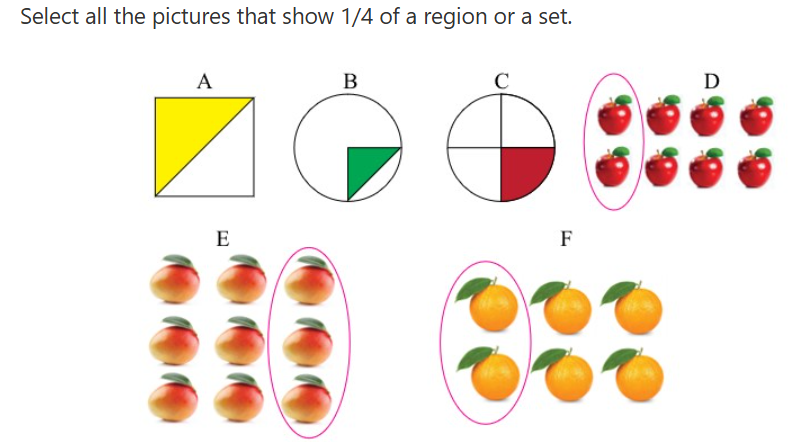
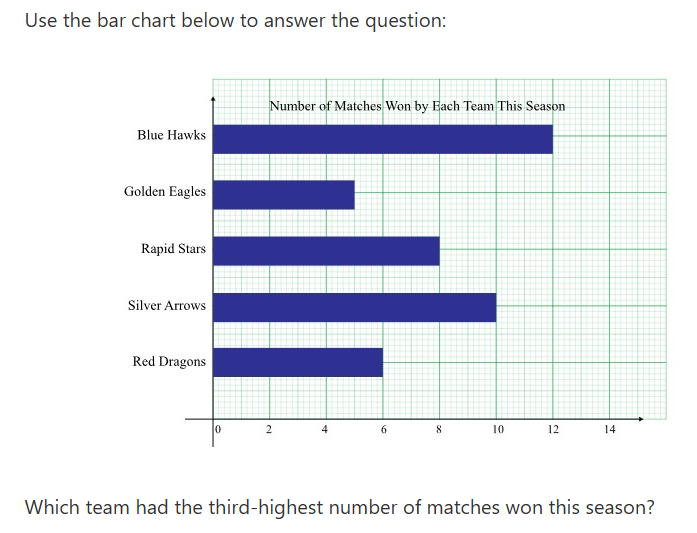
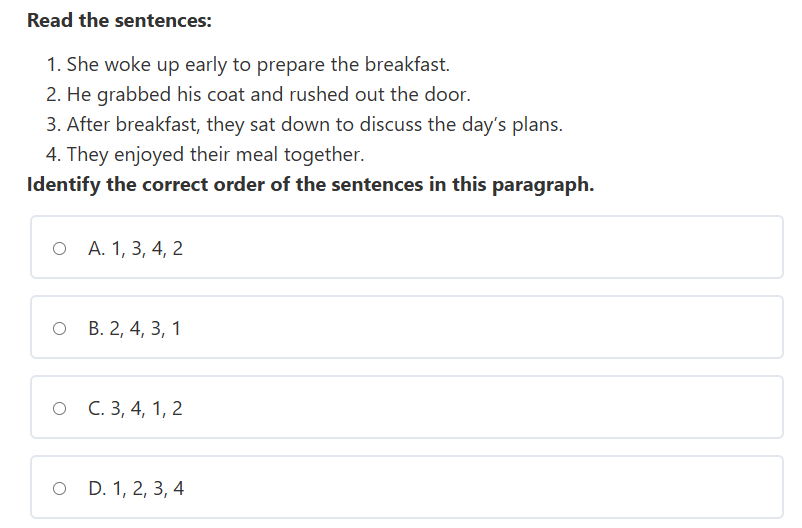
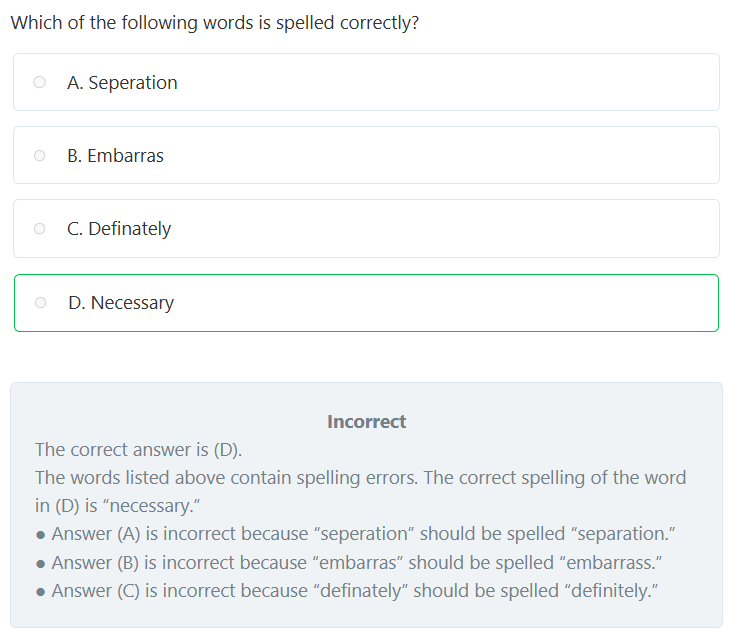


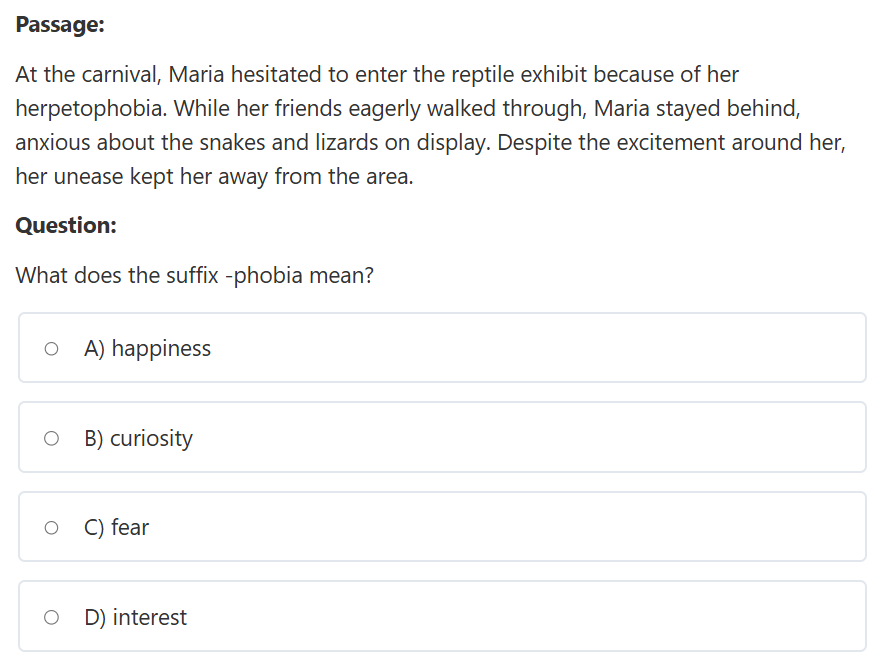
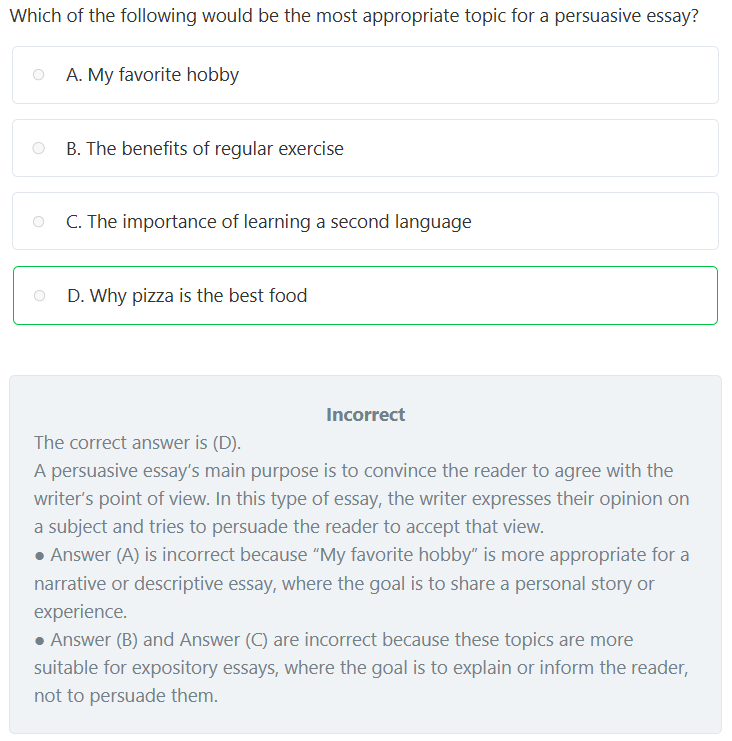
Course Content
One-time Payment & 6-Month Unlimited Access
Overview of the MAP 3rd Grade Math Section
Here is a table outlining the key skill areas assessed in the NWEA MAP Math Test for 3rd Grade, along with descriptions and example questions for each area:
| Skill Area | Description | Example Question |
|---|---|---|
| Operations and Algebraic Thinking | Understanding and solving problems involving multiplication, division, and the relationships between them. Recognizing patterns and understanding properties of operations. | What is the product of 7 and 5? |
| Number and Operations in Base Ten | Working with place value concepts to perform multi-digit arithmetic, including addition and subtraction. Understanding rounding and comparing numbers. | Round 482 to the nearest ten. |
| Fractions | Understanding fractions as numbers, representing them on a number line, and comparing fractions by reasoning about their size. | Which fraction is equivalent to 1/2? |
| Measurement and Data | Solving problems involving measurement and estimation of intervals of time, liquid volumes, and masses of objects. Representing and interpreting data. | If a movie starts at 3:15 PM and lasts for 2 hours and 30 minutes, what time does it end? |
| Geometry | Reasoning with shapes and their attributes, understanding concepts of area and perimeter, and recognizing and drawing shapes having specified attributes. | How many sides does a hexagon have? |
Overview of the MAP 3rd Grade Reading Section
The NWEA MAP Reading test for 3rd grade evaluates students’ proficiency in various reading skills, including comprehension, vocabulary, and analysis.
The primary content areas assessed in the 3rd grade MAP Reading test are as follows:
| Skill Area | Description | Example Question |
|---|---|---|
| Informational Text | Understanding and analyzing non-fiction texts, including identifying main ideas, supporting details, and text structures. | Read the following passage about turtles. What is the main idea of the passage? A) Turtles have fins and live in the water like fish. B) Turtles are mammals that lay eggs. C) Turtles have scales and breathe underwater. D) Turtles are reptiles that live both in water and on land. |
| Literature | Comprehending and interpreting literary texts, such as stories and poems, focusing on elements like theme, plot, character development, and point of view. | Read the following story about Sofia. Where is the story probably taking place? |
| Vocabulary Acquisition and Use | Determining the meaning of words and phrases in context, understanding word relationships, and nuances in word meanings. | Read the sentence: “The scientist resolved to conduct additional experiments to verify the results.” Which word is a synonym for ‘resolved’? A) Agreed |
| Language, Craft, and Structure | Analyzing the author’s word choice, understanding figurative language, and evaluating how text structure and features contribute to meaning. | Read the sentence: “After the announcement, the room erupted like a volcano.” What does this sentence mean? A) The room caught on fire. |
Overview of the MAP 3rd Grade Language Usage Section
The NWEA MAP Language Usage Test for 3rd grade focuses on assessing students’ proficiency in various aspects of language, including grammar, punctuation, sentence structure, and writing strategies.
Here is a table outlining the key skill areas assessed in the 3rd Grade NWEA MAP Language Usage Test, along with descriptions and example questions for each area:
| Skill Area | Description | Example Question |
|---|---|---|
| Grammar and Usage | Understanding and applying correct grammar rules, including subject-verb agreement, verb tenses, and pronoun usage. | Choose the correct word to complete the sentence: “She ___ to the store yesterday.” A) go B) goes C) went D) going |
| Punctuation and Capitalization | Recognizing and using appropriate punctuation marks and capital letters in writing. | Which sentence is punctuated correctly? A) “can you help me with my homework?” asked Tom. B) “Can you help me with my homework?” asked Tom. C) “Can you help me with my homework” asked Tom. D) “can you help me with my homework” asked Tom. |
| Sentence Structure | Identifying and constructing complete sentences, understanding fragments and run-ons, and recognizing different sentence types. | Which of the following is a complete sentence? A) Running through the park. B) Because she was late. C) The dog barked loudly. D) After the movie ended. |
| Writing Strategies | Developing skills in organizing ideas, choosing appropriate words, and constructing coherent paragraphs for effective written communication. | What is the best topic sentence for a paragraph about the benefits of reading? A) Reading is a fun activity. B) Books are made of paper. C) Many people read every day. D) Reading improves your mind and imagination. |
| Spelling | Recognizing correct spelling of grade-level appropriate words and understanding common spelling patterns. | Which word is spelled correctly? A) Frend B) Freind C) Friend D) Frind |
Overview of the MAP 3rd Grade Science Section
The NWEA MAP Science test for 3rd grade evaluates students’ understanding across various scientific domains, including Life Sciences, Physical Sciences, and Earth and Space Sciences, with embedded Engineering Design concepts.
These skill areas align with the Next Generation Science Standards (NGSS).
Here’s a table outlining the key components of the NWEA MAP 3rd Grade Science Test:
| Skill Area | Description | Example Question |
|---|---|---|
| Life Sciences | Understanding living organisms, their life processes, and interactions with the environment. | Which of the following best describes the function of roots in plants? A) To produce seeds B) To absorb water and nutrients C) To attract pollinators D) To perform photosynthesis Answer: B Explanation: Roots absorb water and nutrients from the soil, which are essential for plant growth. |
| Physical Sciences | Exploring the principles of matter and energy, including concepts like force, motion, and the properties of materials. | If you push a toy car with a certain force, what will happen to its speed if you push it harder? |
| Earth and Space Sciences | Studying Earth’s systems, including weather, natural resources, and the solar system. | What causes day and night on Earth? A) The Earth’s revolution around the Sun B) The Moon blocking the Sun’s light C) The Earth’s rotation on its axis D) The Sun moving around the Earth Answer: B Explanation: Day and night are caused by the Earth’s rotation on its axis, leading to different parts of the Earth facing the Sun or away from it. |
Understand the MAP Scores for 3rd Grade
The MAP (Measures of Academic Progress) test provides a RIT (Rasch Unit) score for each subject assessed, such as math, reading, and language usage.
This score reflects your child’s current achievement level and is measured on an equal-interval scale, similar to a ruler, allowing for consistent tracking of academic growth over time.
Understanding RIT Scores:
- Equal-Interval Scale: The RIT scale is stable and equal-interval, meaning the difference between scores remains consistent across the scale. This allows for accurate measurement of a student’s academic knowledge, skills, and abilities, regardless of their age or grade level.
- Growth Measurement: By comparing RIT scores from different testing periods, you can observe your child’s academic progress. For example, an increase in RIT scores over time indicates growth in the subject area assessed.
- Grade-Level Norms: NWEA provides charts showing the median RIT scores for students at various grade levels, which can help determine if your child is performing at, above, or below the typical level for their grade.
To see the RIT scores for 3rd grade and get more specific information, visit our in-depth MAP test scores guide.
Help Your Child Succeed on the MAP 3rd Grade Test
Your child deserves the best preparation to feel confident and perform their best on the MAP test. That’s why we’ve created a thorough practice package tailored specifically to meet their needs.
Comprehensive Practice
Access 420 practice questions across Math, Reading, and Language Usage, carefully designed to cover essential skills tested on the MAP.
Skill-Focused Quizzes
Build your child's confidence and abilities with targeted quizzes that focus on strengthening their knowledge in key subject areas.
One-time Payment & 6-Month Access
100% Satisfaction Guarantee

